
Original Link: https://www.anandtech.com/show/2505
IGP Power Consumption - 780G, GF8200, and G35
by Gary Key on April 18, 2008 2:00 AM EST- Posted in
- CPUs
"Lord, keep my memory green."
That's a great quote from one of best novelists during the Victorian era. If Charles Dickens was writing today, he might be tempted to put a spin on current events by saying, "Lord, keep my products green." As we look around the world today there is one subject that is almost universally discussed, dissected, and leads to arguments as heated as religion or politics. That subject is environmentalism. Put in the simplest terms, we simply say, "…going green…" to describe the current hot topic (pun intended).
Everywhere we look now, there is a story, guideline, or product available that we as a human race can utilize to improve our surroundings and reduce our footprint on this wonderful planet we call Earth. While this article could spin out of control quickly based on your beliefs on what is right or wrong with the environment, we simply want to provide our spin on the power requirements for the latest IGP platforms from AMD, NVIDIA, and Intel.
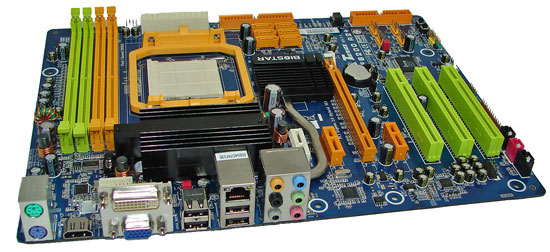
Notice we say platforms. Yes, the chipsets are a very important factor in the overall power consumption of a system, though the main watt robbing items are generally the CPU and GPU. In addition, the number of storage devices, cooling apparatus, and the power supply all play an integral part in the ecosystem we like to call the personal computer.
Our quick look today is by no means a comprehensive review of system power consumption; instead, we are providing an additional focus on the power requirements of the three latest IGP solutions available in the market. We felt like this information would get lost in the multitude of pages in the forthcoming roundup, so a sidebar article seemed appropriate. The results today will provide an extra glimpse into the platform differences when using the same exact components on the AMD side sans the motherboard/chipset and competitive offerings from Intel for comparison. We plan to do the same for our video comparisons between these platforms.
We know the hardware manufacturers are pushing energy conservation from just about every possible angle, including Gigabyte's Dynamic Energy Saver solution and Western Digital's GreenPower series of hard drives. What we would like to know from the readership is if additional articles (more in-depth) centered on platform power efficiencies is something of interest. This type of information would cover categories from HTPC to Gaming, along with recommendations of products that offer the "greenest" performance for your particular system.
That said, let's see which particular
platform wins Al Gore's heart… or if you prefer, which saves you enough pennies
to buy that Hummer you always wanted. (4/22/08 Update - We will provide additional numbers utilizing a
Intel DG35EC motherboard and a new ASUS P5E-VM HDMI BIOS in the near future, initial testing shows the Intel DG35EC providing results about 6~11% better than the ASUS board, additional AMD board results will be provided also)
Test Setup
| Gigabyte MA78GM-S2H Testbed | |
| Processor | AMD Athlon LE1600, 4850E X2, Phenom 9550 |
| CPU Voltage | 1.250V |
| Cooling | AMD Retail |
| Power Supply | Corsair CMPSU-520HX |
| Memory | OCZ PC2-6400 ATI Edition (4x1GB) |
| Memory Settings | DDR2-800, 4-4-4-12 1.90V |
| Video Cards | On-board HD3200 |
| Video Drivers | AMD 8.3 |
| Hard Drive | Samsung HD501LJ |
| Optical Drives | Sony BDU-X10S, LG GGW-H20L |
| Case | Silverstone CW03S-MT |
| Operating System | Windows Vista Ultimate 32-bit |
| . | |
| ASUS P5E-VM HDMI Testbed | |
| Processor | Intel Core 2 Duo E2200 & E7200, Intel Core Quad Q9300 |
| CPU Voltage | 1.250V |
| Cooling | Intel Retail |
| Power Supply | Corsair CMPSU-520HX |
| Memory | OCZ PC2-6400 ATI Edition (4x1GB) |
| Memory Settings | DDR2-800, 4-4-4-12 1.90V |
| Video Cards | On-board X3500 |
| Video Drivers | Intel 15.8 |
| Hard Drive | Samsung HD501LJ |
| Optical Drives | Sony BDU-X10S, LG GGW-H20L |
| Case | Silverstone CW03S-MT |
| Operating System | Windows Vista Ultimate 32-bit |
| . | |
| Biostar TF8200 A2+ Testbed | |
| Processor | AMD Athlon LE1600, 4850E X2, Phenom 9550 |
| CPU Voltage | 1.250V |
| Cooling | AMD Retail |
| Power Supply | Corsair CMPSU-520HX |
| Memory | OCZ PC2-6400 ATI Edition (4x1GB) |
| Memory Settings | DDR2-800, 4-4-4-12 1.90V |
| Video Cards | On-board GeForce 8200 |
| Video Drivers | NVIDIA 174.74 / 18.11 Platform |
| Hard Drive | Samsung HD501LJ |
| Optical Drives | Sony BDU-X10S, LG GGW-H20L |
| Case | Silverstone CW03S-MT |
| Operating System | Windows Vista Ultimate 32-bit |
| . | |
Our tests today will concentrate on platform power requirements when playing back High Definition content and taking a leisurely flight around the Honolulu harbor with Flight Simulator X. We utilized PCMark Vantage to track power requirements for general office/home applications. The results were very similar to our HD playback scores so we omitted them for this particular article. We are not providing overclocking or discrete GPU numbers in today's article; this is all about the base setups we utilized for testing these chipsets.
Based on the 780G's penchant for HD playback and casual gaming, we figured the natural competitors in this particular segment would be the Intel G35 and NVIDIA GeForce 8200. Fortunately, we had several GeForce 8200 retail boards arrive this week. NVIDIA provided WHQL platform (18.11) and GPU (174.74) drivers on their website last week. However, these drivers still do not provide Hybrid SLI or HybridPower capabilities. We have already noticed several problems ranging from HDMI synchronizing to the inability of PowerDVD 8.0 or WinDVD 9.0 to recognize the driver set for playback capabilities in certain situations.
We selected identical components for our three testbeds, with the obvious exception of the motherboard and CPU. Our choice of processors represents three different levels. Our minimum spec processors consist of the AMD Athlon LE1600 and Intel Core 2 Duo E2200. Both of these processors are the recommend minimum we would use on these platforms in order to provide acceptable results with HD playback, general applications, and casual gaming. Our 2.5GHz capable AMD 4850e X2 and upcoming Intel E7200 represent a middle ground in performance. These two processors are the ones we would most likely purchase for our platforms. Our final selection consists of the latest entry-level quad-core processors from AMD and Intel, the Phenom 9550 and Core 2 Quad Q9300.
Idle Tests
We enabled the power management capabilities of each chipset in the BIOS and set our voltage selections to auto except for memory. We set memory to 1.90V to ensure stability at our timings. The boards would default to 1.80V or 1.85V, but we found 1.90V necessary for absolute stability in our configurations at the rated 4-4-4-12 timings.
On the two AMD boards, this resulted in almost identical settings with the exception being chipset voltages, although those were within a fraction of each other. Overall, each of the CPUs hovered around 1.250V and all power management options functioned perfectly on these particular board choices. We then set Vista to use either the Performance or Balanced profiles depending on test requirements.
We typically run our machines with the balanced profile. Using the Power Savings setting resulted in a decrease of 1W to 5W depending on the CPU and application tested. At idle, the Balanced and Power Savings profiles both set the minimum value for processor power management to 5%, while the maximum is set to 100% for Balanced and 50% for Power Savings. The Performance setting sets both values to 100% and is the reason for the increases in power requirements even if you have power management turned on in the BIOS.
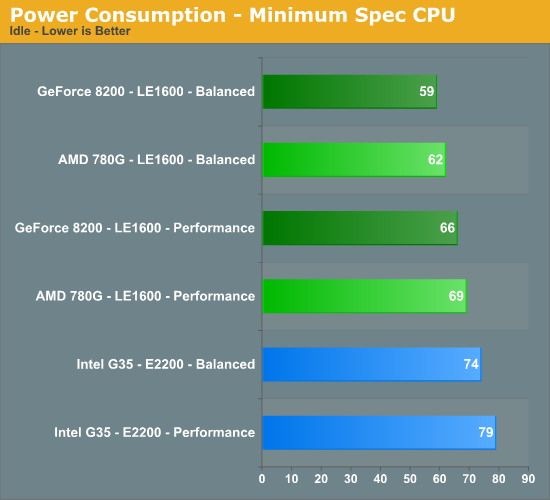
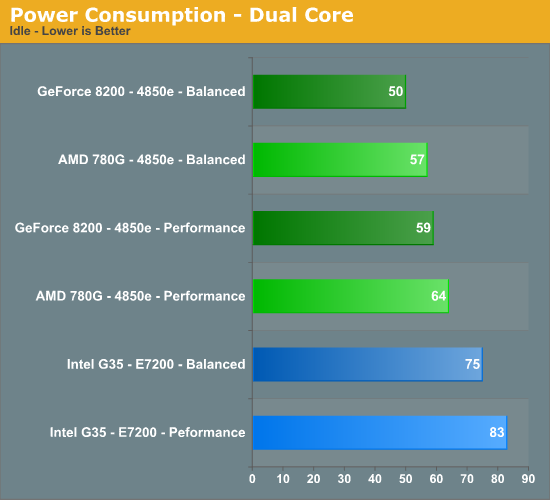
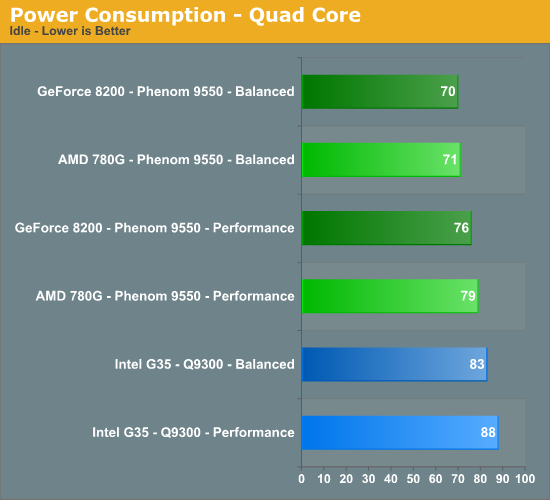
The
results surprised us - more like floored us. The same company that brings you
global warming friendly chipsets like the 680i/780i has suddenly turned a new
leaf, or at least saved the tree it came from. We see the GeForce 8200 besting
the AMD 780G and Intel G35 platforms in our minimum spec configuration utilizing
the Power Saving profile by 3W and 15W respectively. To be fair to Intel, we
are comparing a single core AMD processor to a dual-core processor. However,
these are the minimum CPUs we would utilize. (4/19/08 Update - Minimum Spec chart is correct now)
Frankly, the AMD LE1600 is just on the verge of not being an acceptable processor during HD playback. The LE1600 was able to pass all of our tests, but the menu operation was slow when choosing our movie options and CPU utilization did hit the upper 90% range on some of the more demanding titles even with the 780G or GF8200 providing hardware offload capabilities.
The pattern changes slightly with the dual-core setup having a 7W and 25W advantage for the GF8200. Our quad-core results are almost even with the GeForce 8200 board from Biostar having only a 1W difference compared to the Gigabyte 780G setup. The GeForce 8200/Phenom 9550 combo comes in with a 13W advantage over the Q9300 on the ASUS G35 board.
MPEG2 HD Test
Our test setup remains the same as the idle power tests with the Vista power profile set to Balanced. Our feature title is Crank, with a video bitrate up to 37Mbps and an uncompressed PCM soundtrack rated at 6144Kbps or a Dolby Digital Surround 5.1 EX track at 640Kbps.
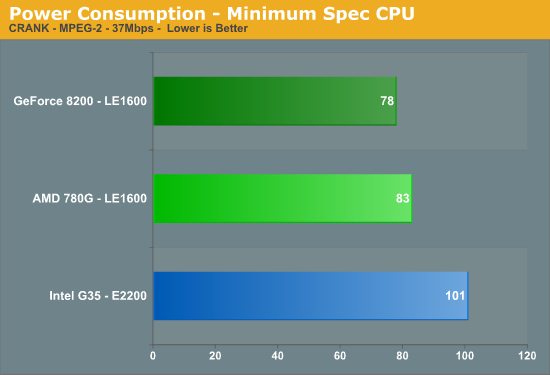
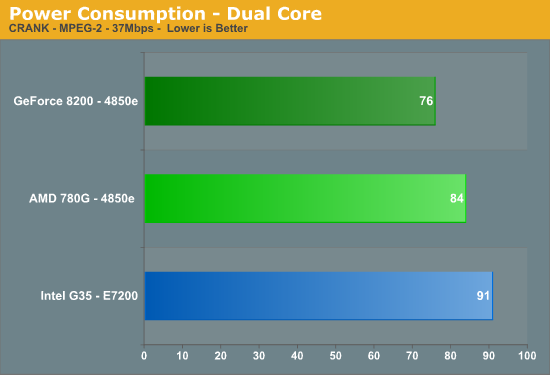
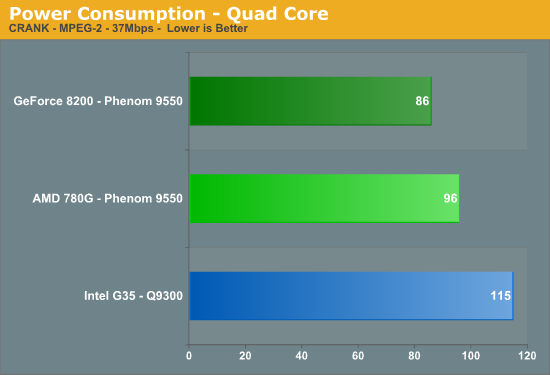
Much like our idle tests, the advantages go to the Biostar TF8200 A2+ board equipped with the GeForce 8200 chipset. The results are an 18W and 25W advantage with the low-end CPUs, 8W and 15W with the dual cores, and an outstanding 10W and 24W difference with the quad cores.
Our initial CPU utilization testing shows the GeForce 8200 and 780G chipsets to be nearly identical so we can negate any potential differences in this area. We are still analyzing the new image quality results, but they seem to be very close so far. We will temper our excitement for now, as new drivers that implement several missing features should be available shortly. We will revise our numbers if there are any significant changes.
H.264 HD Test
We once again have the same test setup and the Vista power profile is set to Balanced. One of our favorite movies last year and one that provides some stress for playback is The Simpsons Movie. It features a video bitrate up to 40Mbps with a 5.1 DTS-MA soundtrack rated at 3960+Kbps.
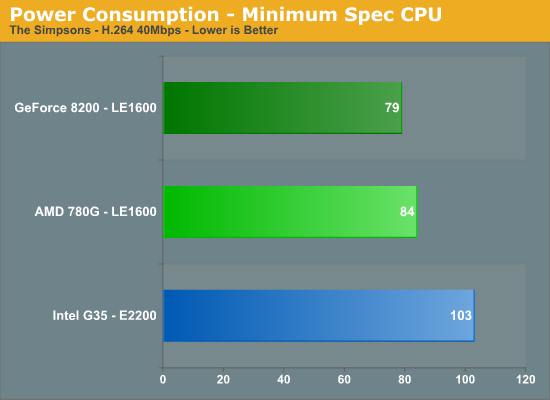
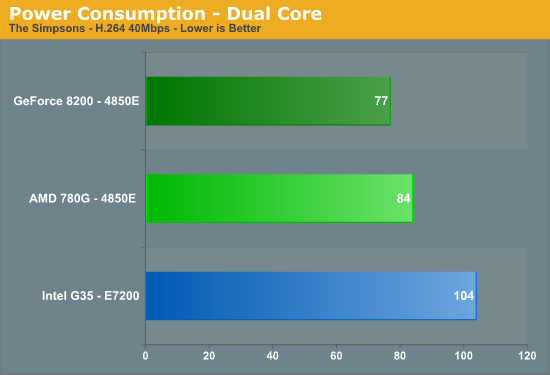
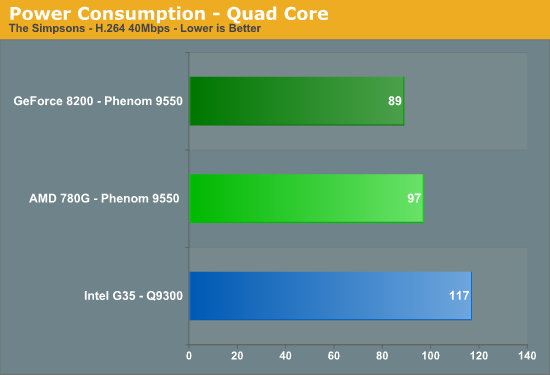
Following in the footsteps of our Crank test, the GeForce 8200 chipset once again shows its strength, saving earth's resources one small step at a time. The results are a 5W and 24W advantage with the low-end CPUs, 7W and 27W improvement with the dual cores, and 8W and 28W difference with the quad cores.
No matter how good the E7200 (details coming shortly) is as a low budget 45nm dual-core CPU, the G35 chipset hampers it since H.264/VC-1 offloading is not available. We will have to wait for the next generation G45 for a fair fight between these chipsets. Of course, by that time, AMD will have the 790GX and NVIDIA will be launching the GeForce 8300 series. In the meantime, the G35 is perfectly capable as an HTPC choice when paired with the right CPU, driver set, and playback application. Just don't expect it to be the coolest running green machine on the block.
Flight Simulator X Test
Whether playing Solitaire since the Windows 3.0 days or flying around your favorite locale in the longest running series on the PC, casual gaming on the PC is an activity just about everyone with a PC has done at one time or another. Our test today consists of a flight around the Honolulu harbor area and is something all three chipsets can handle, with the appropriate settings and resolutions. The actual winner is the 780G chipset, but what we are concerned about is how many dollars your electric company will collect when you relax and play a game.
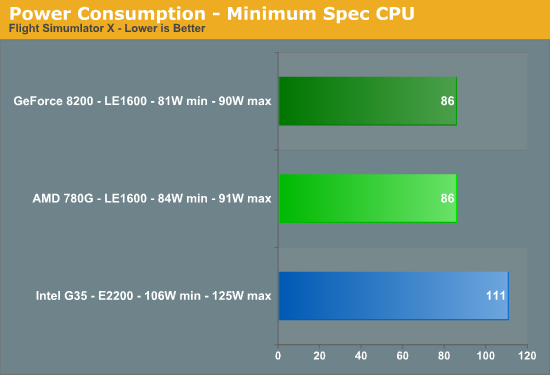
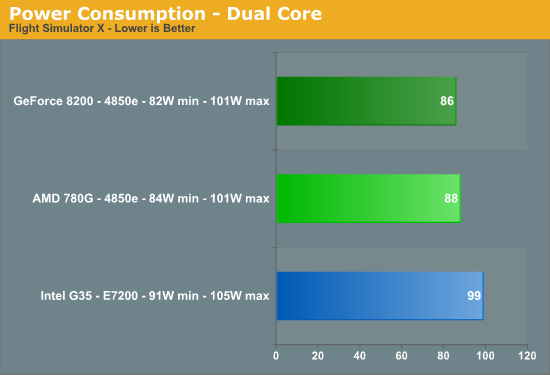
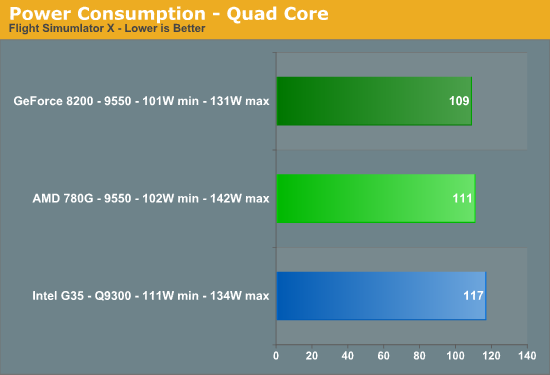
We listed minimum and maximum voltages during our six-minute trip around the harbor, but the charts show the average. The current version of Flight Simulator X with the Acceleration Pack is fully multi-core aware and provides a workout for both the CPU and GPU as you crank up the settings. Our AMD LE1600 is a single-core CPU so the voltage variations are not as great compared to the multi-core CPUs. This processor stayed near the 100% utilization level during FSX testing, although frame rates did not seem to suffer that much at our 1024x768 medium settings.
The results are closer this time around between our two AMD platform chipsets. The GeForce 8200 once again finishes slightly in the lead but our upcoming gaming tests will show it following in the footsteps of the AMD 780G. The results are a tie between the AMD chipsets but a 25W advantage over G35 with the low-end processors, a 2W and 13W improvement with the dual cores, and a soft landing with 2W and 8W differences between the quad cores.
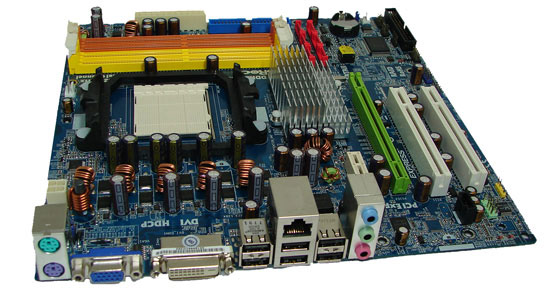
First Thoughts
We told you it would be a short article. However, we think the results today should provide a better indication to each platform's power requirements with a variety of CPUs likely to end up in these boards and applications that tend to stress those same processors. Unless the next NVIDIA driver set increases power consumption, then we have a surprise winner between the latest IGP chipsets from the big three. The next question we will answer is performance per watt and those results are likely to lead us down another path.
The power bill savings alone are not that large, of course. Running 24/7, 365 days per year, a 10W power difference works out to 87.6 kWh of energy over the course of a year. At a rate of 10 cents per kWh, that would work out to less than a dollar per month. In the bigger picture, however, the 5W to 25W difference between chipsets or platforms can be far more meaningful. If you want a silent - or at least very quiet - PC, every watt saved can be meaningful. Cooler running chipsets can also avoid the need for "noisy cricket" fans or monstrous cooling configurations. All other things being equal, we would definitely prefer less power-hungry components.







